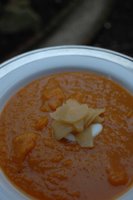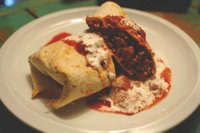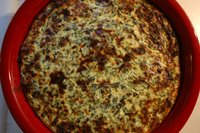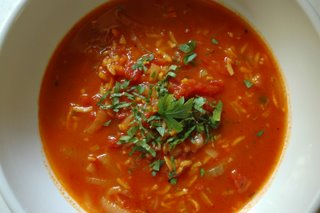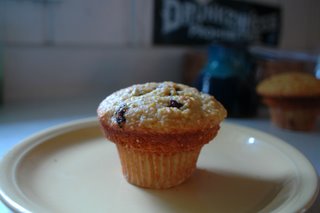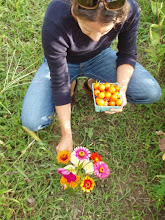
I've become a huge fan of chicken legs lately. They aren't dry and
boring like some poultry cuts I know (ehem, chicken breast), they are
cheap enough to justify spending those dollars you save elsewhere
(like the wine aisle). They make for a handsome presentation, and
they work wonderfully in braises.
Braising is something I've been doing a lot lately; maybe because of
the change in seasons, or my new book on braising ,or maybe just
because it works so beautifully, and is so easy.
I tore this recipe out of Everyday Food, that
pint-sized magazine which the grande dame of domesticity publishes.
This is a magazine which I've been suspicious of in the past. The
recipes always appear to be too simplistic. I can appreciate cutting
a few corners for the sake of a quick weeknight meal, but microwaving
a beef stew? A pea soup recipe with 4 ingredients? I have my doubts
about these things.
Despite my snobbery, I thought this recipe look promising - it was
short on ingredients, but you could tell it would be big on
flava'. The chicken legs were braised with onion, prunes, and
a trio of spices - tumeric, ginger and cinnamon. I took the liberty
of adding some cayenne, some honey, and some cilantro to the braising
mixture, and used chicken broth instead of water. The chicken is
served alongside roasted carrots, dressed in lemon, olive oil, salt
and fresh ground black pepper, and all this is set atop a bed of
couscous, to which I added olive oil, lemon juice, cilantro. If
you're one of those people who has a thing against fruit and meat
sharing a plate, then perhaps you could add some almonds, which would
have been a great idea anyways, but as it was, this was an
outstanding weeknight meal.
Moroccan Braised Chicken
Adapted from Martha Stewart's Everyday Food
For Chicken:
2 Chicken Legs, trimmed of excess fat
2 Tbsp olive oil
1/2 yellow or sweet onion, sliced to a medium thickness
Coarse Salt and Ground Pepper
1/4 tsp tumeric
1/4 tsp ground ginger
1/8 tsp ground cinnamon
Pinch of cayenne
10 pitted prunes
1-2 Tbsp honey
1/2 cup cilantro stems and leaves, washed well
1 1/2 - 2 cups chicken broth
Toasted sliced almonds, (optional)
For Carrots
1 bunch carrots, peeled and cut on the bias into large chunks
1-2 Tbsp olive oil (a good drizzle)
Course salt and fresh ground pepper
1/2 lemon
For Couscous
1 cup couscous
1 3/4 cups water
1/4 cup chopped cilantro leaves
1-2 Tbsp olive oil
Course salt and fresh ground pepper
1/2 lemon
Directions
Preheat your oven to 425 degrees. Toss the carrots with the olive
oil, a few squeezes of lemon, and season with salt and pepper. Place
the carrots on a rimmed baking sheet and place in the oven to roast
until cooked through and deeply browned, adjusting the heat if
necessary. This will take anywhere from 20 - 40 minutes depending on
your carrots. Keep an eye on them though - and turn the oven down if
they are browning too quickly. When the carrots are done, toss them
with additional lemon juice.
Heat the olive oil in a heavy skillet over medium to medium-high
heat. Season the chicken with salt and pepper and add to the hot pan
to brown both sides until they are crisp, and golden brown. Set the
chicken aside on a plate, and pour out all but enough oil and
drippings to keep the bottom of the pan coated with fat. Turn down
the heat and add the onions, seasoning with salt and pepper. Saute a
few minutes, then add the spices, stirring to coat, and release their
flavor. Place the chicken legs back in the pan, on top of the
onions, and add the broth, prunes, honey and cilantro. Bring to a
boil, then turn down the heat to low, cover, and simmer gently.
Meanwhile, make the couscous. Place the couscous, olive oil, lemon
juice, and cilantro together in a medium bowl. Season with salt and
pepper. Bring the water to a boil and pour over the couscous. Cover
with plastic wrap to steam.
The chicken is done when it's cooked through - 20 minutes or more,
depending on the thickness. To serve, place a mound of couscous in
the bottom of a bowl (you want something to catch those juices!),
place a chicken leg on each, and arrange the carrots, and prunes &
onions from the sauce around the chicken. (I discarded the cilantro
stems). Taste the sauce - if it's weak, turn up the heat on your
stove and reduce the sauce until thickend slightly. Pour the sauce
around the chicken, and garnish with additional cilantro leaves, or
almonds if desired.
Serves 2





